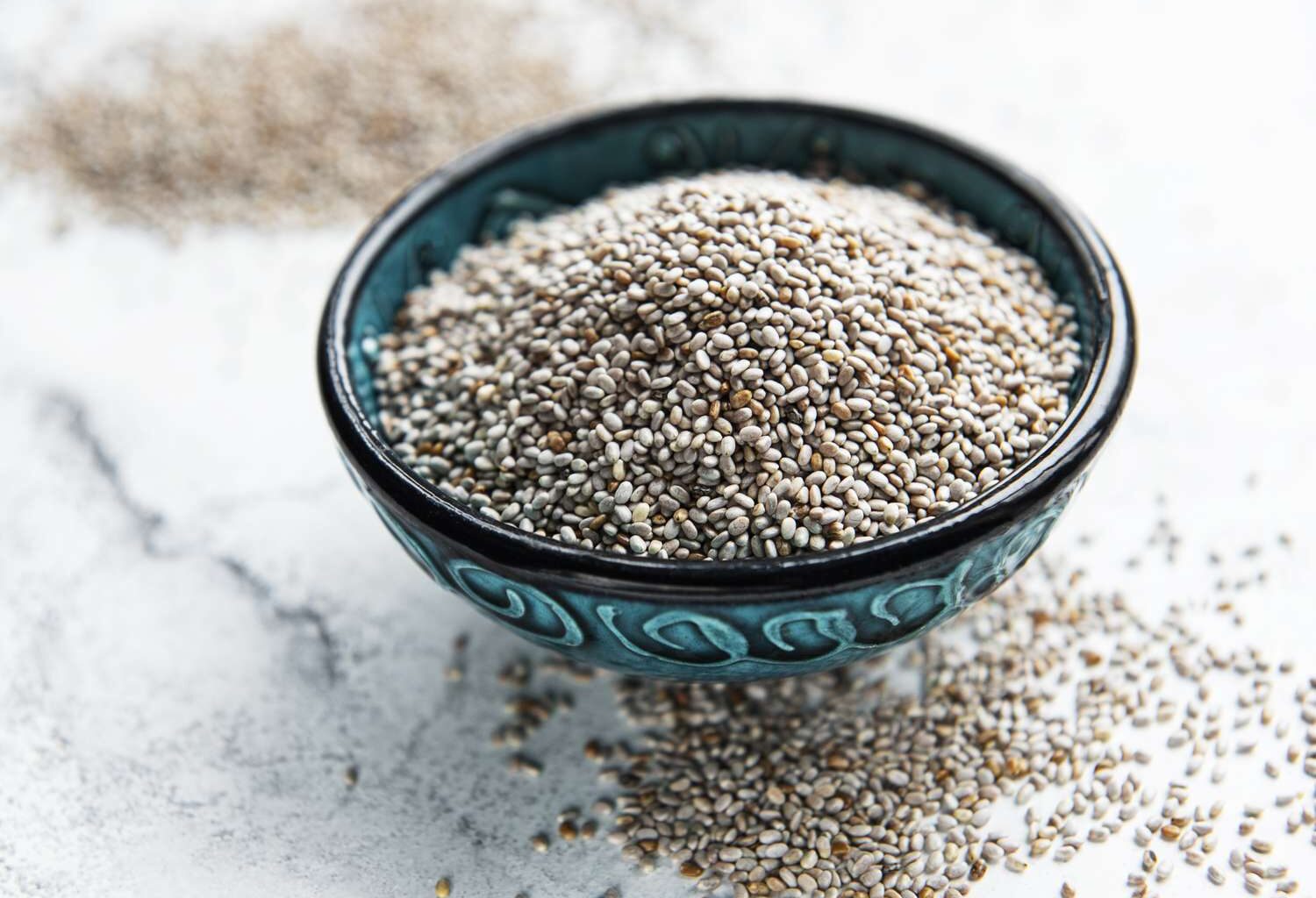Omega-3 fatty acids have positive effects on heart and brain function and may help reduce inflammation. Chia seeds are rich in omega-3 fatty acids, containing 5.06 grams per ounce, although other foods can also provide these essential fats.
1. Flaxseed Oil
Irina Vodneva / Getty Images
Flaxseed oil is one of the few foods that exceeds chia seeds for omega-3 fatty acids per serving. One tablespoon provides 7.26 grams of alpha-linolenic acid (ALA), a type of omega-3 found in plant oils.
2. Flaxseeds and Hemp Seeds
PicturePartners / Getty Images
Flaxseed and hemp seeds provide substantial amounts of healthy fats, protein, fiber, and bioactive plant compounds that contribute to notable health benefits.
Both seeds are rich sources of omega-3 fatty acids, including the anti-inflammatory ALA:
15 grams (about 2 tablespoons) of ground flaxseeds yield 2.9 grams of ALA.30 grams (3 tablespoons) of hulled hemp seeds yield 2.6 grams of ALA.
3. Walnuts
JamieRogers1 / Getty Images
Walnuts contain omega-3 fatty acids, primarily ALA. They also have antioxidants and have been studied for potential effects on brain health, heart disease risk, and certain types of cancer.
Walnuts can be included in plant-based diets as a source of omega-3 fatty acids. One ounce of English walnuts provides 2.7 grams of ALA omega-3 fatty acids.
4. Fatty Fish
LauriPatterson / Getty Images
EPA/DHA Amounts in Fatty Fish
Fatty Fish Variety
EPA/DHA per 3 oz.
Wild salmon
1.0-3.0 grams
Halibut
2.21 grams
Herring
1.7–1.8 grams
Sardines
1.0–1.74 grams
Trout
1.0 grams
Tuna
0.25–1.30 grams
Mackerel
0.35–1.80 grams
Fatty fish (including salmon, herring, halibut, sardines, and tuna) provide long-chain omega-3 fatty acids, including eicosapentaenoic acid (EPA) and docosahexaenoic acid (DHA), which possess anti-inflammatory properties. EPA and DHA can help reduce the production of inflammatory molecules and compounds.
Different fatty fish varieties yield different amounts of EPA/DHA, with wild salmon providing more than other fatty fish varieties at around 3 grams per 3-ounce serving.
Researchers have examined potential health effects associated with consuming fatty fish. For example:
A 2023 study by researchers at the University of Eastern Finland found that fatty fish intake is associated with a lower lipophilic index, which correlates with larger high-density lipoprotein (HDL, good) cholesterol particles and a decreased risk of heart disease.Consumption of fatty fish has been linked to a 12% lower risk of cancer mortality and an 18% reduction in overall mortality.Diets rich in fatty fish may support cognitive function and help protect against neurodegenerative conditions such as Alzheimer’s disease.
5. Algae
Fuzullhanum / Getty Images
Algae, including seaweed, nori, and chlorella, are eaten for their nutritional benefits. They provide omega-3 fatty acids, which can be beneficial for individuals who do not consume meat.
Algae are among the few non-animal foods that contain ALA, EPA, and DHA, though levels vary by type or product. Further, algae oil is one of the richest sources of ALA.
Seaweed also supplies protein and offers antioxidant, antidiabetic, and antihypertensive properties.
6. Edamame or Soybean Oil
AndreySt / Getty Images
Edamame are immature soybeans, known for their omega-3 fatty acids and protein content. Additionally, edamame provides a substantial amount of fiber and phytonutrients—beneficial compounds that support the body’s defense against various diseases. A single serving offers 0.28 grams of alpha-linolenic acid (ALA).
Soybean oil is another source of omega-3 fatty acids, delivering 0.92 grams of ALA per serving.
7. Omega-3 Fortified Foods and Beverages
I Wayan Suarnaya / Getty Images
Since certain foods do not naturally contain high levels of omega-3 fatty acids, manufacturers will sometimes fortify them with omega-3 fatty acids.
Some omega-3 fortified foods are:
EggsBreadsCookies, cakes, and other baked goodsFruit juiceDairy products, including milk and yogurtButter and margarineCooking oilsBaby food
What Are Omega-3 Fatty Acids?
ALA, EPA, and DHA Content of Selected Foods
Food
Grams per serving
ALA
DHA
EPA
Flaxseed oil, 1 tbsp
7.26
Chia seeds, 1 oz
5.06
English walnuts, 1 oz
2.57
Canola oil, 1 tbsp
1.28
Salmon, Atlantic, farmed 3 oz
1.24
0.59
Salmon, pink, canned, 3 oz
0.04
0.63
0.28
Oysters, 3 oz
0.14
0.23
0.30
Sea bass, 3 oz.
0.47
0.18
Lobster
0.04
0.07
0.10
Chicken
0.02
0.01
Milk
0.01
Source: National Institutes for Health
Omega-3 fatty acids are essential fats that the human body cannot produce, so you must obtain them through your diet. The three main types are:
Alpha-linolenic acid (ALA): Found in plant oilsEicosapentaenoic acid (EPA): Found in fish and algaeDocosahexaenoic acid (DHA): Found in fish and algae
These fatty acids offer several health benefits, including:
Heart health: Help lower cholesterol, reduce blood pressure, and lower the risk of heart diseaseBrain health: Support brain development and may reduce cognitive declineAnti-inflammatory effects: Beneficial for reducing inflammation in conditions like inflammatory arthritis
The National Institutes of Health recommends a daily intake of 1.6 grams for adults assigned male at birth and 1.1 grams for adults assigned female at birth. Pregnant individuals should aim for 1.4 grams daily, while breastfeeding individuals should aim for 1.3 grams daily.
Most people can obtain enough omega-3 fatty acids through their diets. However, if you are worried that you might not be getting enough, it’s best to consult a healthcare provider for guidance before considering supplements.
Verywell Health uses only high-quality sources, including peer-reviewed studies, to support the facts within our articles. Read our editorial process to learn more about how we fact-check and keep our content accurate, reliable, and trustworthy.
National Institutes of Health. Omega-3 fatty acids – health professional fact sheet.
Kaçar ÖF, Kose T, Kaya Kaçar H. Dietary hempseed and cardiovascular health: nutritional composition, mechanisms and comparison with other seeds. Front Nutr. 2025;12:1669375. doi:10.3389/fnut.2025.1669375
USDA FoodData Central. Flaxseed, ground.
USDA FoodData Central. Seeds, hemp seed, hulled.
Fan N, Fusco JL, Rosenberg DW. Antioxidant and anti-inflammatory properties of walnut constituents: focus on personalized cancer prevention and the microbiome. Antioxidants (Basel). 2023;12(5):982. doi:10.3390/antiox12050982
DiNicolantonio JJ, O’Keefe J. The importance of maintaining a low omega-6/omega-3 ratio for reducing the risk of autoimmune diseases, asthma, and allergies. Mo Med. 2021;118(5):453-459.
Kavyani Z, Musazadeh V, Fathi S, Faghfouri AH, Dehghan P, Sarmadi B. Efficacy of the omega-3 fatty acids supplementation on inflammatory biomarkers: An umbrella meta-analysis. Int Immunopharmacol. 2022;111:109104. doi:10.1016/j.intimp.2022.109104
Lyytinen AT, Yesmean M, Manninen S, et al. Fatty fish consumption reduces lipophilic index in erythrocyte membranes and serum phospholipids. Nutr Metab Cardiovasc Dis. 2023;33(7):1453-1460. doi:10.1016/j.numecd.2023.04.011
Marino P, Mininni M, Deiana G, et al. Healthy lifestyle and cancer risk: Modifiable risk factors to prevent cancer. Nutrients. 2024;16(6):800. doi:10.3390/nu16060800
Welty FK. Omega-3 fatty acids and cognitive function. Curr Opin Lipidol. 2023;34(1):12-21. doi:10.1097/MOL.0000000000000862
Rocha CP, Pacheco D, Cotas J, Marques JC, Pereira L, Gonçalves AMM. Seaweeds as valuable sources of essential fatty acids for human nutrition. Int J Environ Res Public Health. 2021;18(9):4968. doi:10.3390/ijerph18094968
Kunj P, Sahu S, Singh G, Arya SK. A review on algal oils as a sustainable source of essential omega-3 fatty acids. Bioresour. Technol. 2025;30:102154. doi:10.1016/j.biteb.2025.102154
Admassu H, Gasmalla MAA, Yang R, Zhao W. Bioactive peptides derived from seaweed protein and their health benefits: Antihypertensive, antioxidant, and antidiabetic properties. J Food Sci. 2018;83(1):6-16. doi:10.1111/1750-3841.14011
Zhang Q, Li Y, Chin KL, Qi Y. Vegetable soybean: Seed composition and production research. Ital. J. Agron. 2017;12(3):872. doi:10.4081/ija.2017.872
Patel A, Desai SS, Mane VK, Enman J, Rova U, Christakopoulos P, Matsakas L. Futuristic food fortification with a balanced ratio of dietary ω-3/ω-6 omega fatty acids for the prevention of lifestyle diseases. TIFS. 2022;120:140-153. doi:10.1016/j.tifs.2022.01.006

Thanks for your feedback!
What is your feedback?
Helpful
Report an Error
Other
Verywell Health
is part of the People Inc. publishing family.
By clicking “Accept All Cookies”, you agree to the storing of cookies on your device to enhance site navigation, analyze site usage, and assist in our marketing efforts.
Cookies Settings Accept All Cookies

